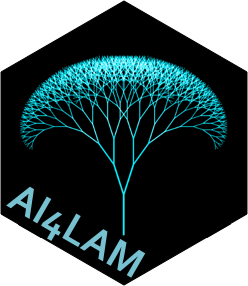Conference Agenda
Overview and details of the sessions of this conference. Please select a date or location to show only sessions at that day or location. Please select a single session for detailed view (with abstracts and downloads if available).
Please note that all times are shown in the time zone of the conference. The current conference time is: 25th Dec 2025, 03:35:49am GMT
|
Session Overview |
| Session | ||
KNC: Keynote: 'What Are We Looking At : Massive Models and Minimal Description' and close
| ||
| Session Abstract | ||
Our closing keynote speaker is Dorothy Berry.Dorothy Berry is an archivist, curator and writer whose first book, The House Archives Built and Other Thoughts on Black Archival Possibilities was released by We Here Press in 2025. Her career is informed by archival methodologies developed at a range of cultural heritage institutions, where she continues to implement creative, digital methods to make archival collections related to Black life available more broadly. 'What Are We Looking At : Massive Models and Minimal Description'Access to digitally reformatted physical collections is a standard service of LAMs in the 21st century, but much of the methodology for discovery is based on 19th century technology which has directly digitally reformatted in its own ways: from paper catalog card to circulation management systems, from bound finding aids to archival discovery platforms. Descriptive schemas created to work in collaboration with the facilitation of a reference librarian or archivist in a reading room can leave digital patrons without enough information. All sorts of AI-coded innovations have been proposed and experimented with to meet the challenges presented by digital collections, with publications across LAM institutions showing varying levels of success. The Johnson Publishing Company Archive, co-stewarded by the Getty and the National Museum of African American History and Culture, is many things at once: millions of digital files with relatively minimal descriptive metadata, the single largest archival collection processed, digitized, and preserved by either institution, a peerlessly expansive photographic record of Black life in the 20th century. The intersections of expertise across institutions and across ideas of the project’s primary purpose have led to particularly timely questions around the use of AI in LAM collections representing marginalized populations. Differences in disciplinary values and goals have raised questions about consent, access, AI, and ethics. Using the issues of alt-text and image description as a microsite for examination, this talk explores the possibilities presented by the Johnson Publishing Company Archive, a multi-million image collection from the 20th century’s largest Black Media Empire. With a streamlined workflow of ongoing folder-level archival processing, digitization, ingest, and then both physical and digital delivery, innovative descriptive solutions using computer vision and LLMs have a broad appeal. By presenting a discussion of legal and ethical requirements around alt-text, image description, and archival description alongside with the promised potential of AI to bridge resource gaps, this talk is designed to question how and why we describe archives. |
